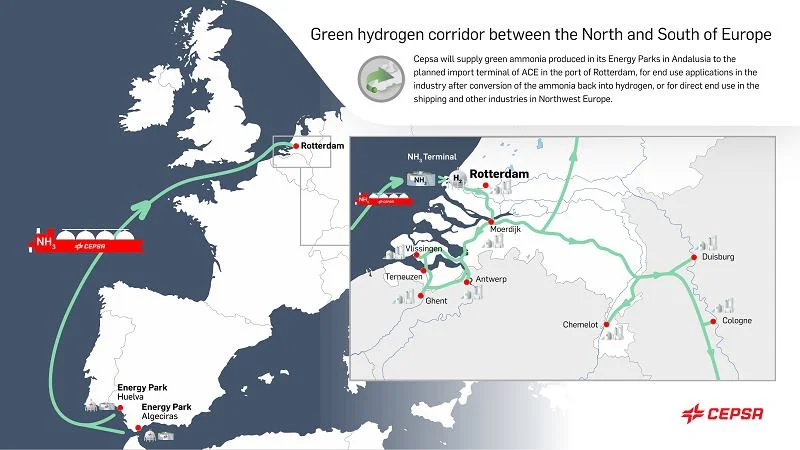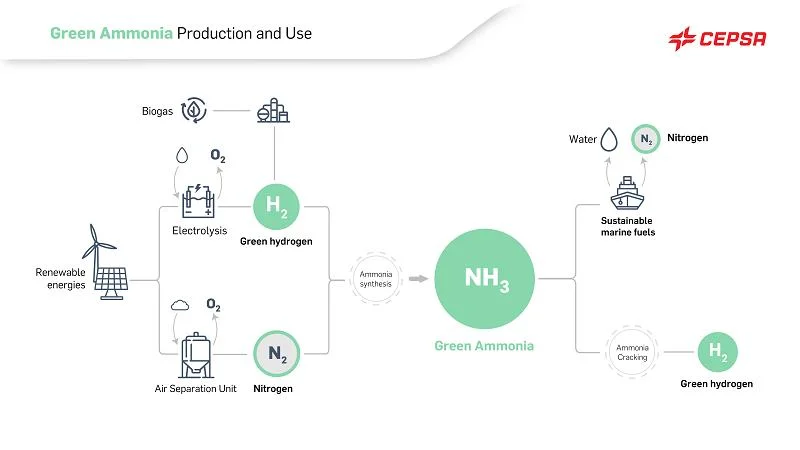CEPSA and Yara Clean Ammonia forge alliance to connect Southern and Northern Europe with green hydrogen, in the presence of the Kings of Spain and the Netherlands.
- The two companies have agreed on a strategic partnership to set up the first green hydrogen maritime corridor between the ports of Algeciras and Rotterdam for the decarbonization of European industry and maritime transport
- The alliance incorporates Yara Clean Ammonia as the newest partner of the Andalusian Green Hydrogen Valley, where Cepsa plans to build a new green ammonia plant at its energy park in San Roque, Cádiz, near the port of Algeciras, with a 1-billion-euro investment and the creation of 3,300 jobs. It will be the largest green ammonia project in Europe with an annual production capacity of up to 750,000 tons, which will prevent up to 3 million tons of CO2 from being emitted
- The partnership also envisages Yara Clean Ammonia supplying Cepsa with green ammonia volumes, which will allow the energy company to get a head start in establishing the green hydrogen corridor and lead the initiative to serve industrial and marine customers in Rotterdam and Central Europe
- Cepsa also signed an agreement with Dutch company Gasunie that guarantees access to its green hydrogen transport network in the Netherlands, which will connect the Port of Rotterdam with other European industrial clusters in Germany, the Netherlands, and Belgium as part of the Delta Corridor project
- The above agreements will consolidate the development of the Andalusian Green Hydrogen Valley, the largest green hydrogen project in Europe with 2 GW of electrolysis capacity and an overall investment of 3 billion euros
- Their Majesties King Felipe VI and King Willem-Alexander witnessed the signing ceremony, underlining the collaboration between the two countries to accelerate the net-zero carbon energy transition and achieve energy independence for Europe
Their Majesties the King of Spain, Felipe VI, and the King of the Netherlands, Willem- Alexander, today witnessed the signing of a commercial partnership agreement between Cepsa and the Norwegian multinational Yara Clean Ammonia, a global leader in the field of clean ammonia, under which the two companies will set up the first green hydrogen maritime corridor between southern and northern Europe, connecting the ports of Algeciras and Rotterdam as part of efforts to boost decarbonize industry and maritime transport on the continent.
As part of the Andalusian Green Hydrogen Valley, Cepsa will develop a green ammonia plant at its San Roque Energy Park in Cadiz that will be operational in 2027. With an investment of 1 billion euros, it will be the largest plant in Spain and one of the largest in Europe. The project, which could include potential partners, will create 3,300 jobs – including direct, indirect and induced – and a new market in Algeciras for green ammonia, a product derived from green hydrogen that can be used both as a sustainable marine fuel and as a carrier of green hydrogen for its transportation to distant locations.
The alliance with Yara Clean Ammonia will help establish a safe, resilient, and cost-efficient supply chain for delivering green ammonia and paves the way for Cepsa to deliver the first green hydrogen molecules to its customers by using Yara Clean Ammonia’s global supply base and logistical footprint. This will in turn allow the energy company to start marketing green hydrogen and green ammonia to industrial customers and maritime customers in Rotterdam and Central Europe.
The event was also attended by the Third Vice President and Minister for Ecological Transition and Demographic Challenge, Teresa Ribera, the Minister for Climate and Energy Policy of the Netherlands, Rob Jetten, the President of the Junta de Andalucía, Juan Manuel Moreno Bonilla, the President of the Port of Algeciras, Gerardo Landaluce, and the Director of the Port of Rotterdam International, René van der Plas, among other authorities.
The new green ammonia plant will be powered by green hydrogen produced by Cepsa and EDP at the 1 GW plant to be developed in Campo de Gibraltar. It will have an annual production capacity of up to 750,000 tons of ammonia, which can prevent 3 million tons of CO2 emissions. Yara, a global leader in ammonia production, has extensive experience in this market, which will ensure the development of a viable green energy corridor in Europe. Cepsa will offer its extensive experience in producing fuels and its knowledge of the maritime sector to support its customers’ decarbonization strategy.
Yara Clean Ammonia is part of Yara International, which has its largest ammonia and fertilizer plant in the Netherlands. Since 1929, the Dutch Yara site is located in Sluiskil on the Ghent-Terneuzen canal, a major deep-sea waterway opening into the North Sea and connecting European inland rivers and railway all over Europe. This largest fertilizer production site in western Europe is highly integrated and belongs to the top of most efficient plants on world level.

At the same ceremony, in the presence of Their Majesties, Cepsa also signed an agreement with Hynetwork Services, the Gasunie subsidiary that owns the green hydrogen transport network in the Netherlands. With this agreement, Cepsa’s green hydrogen receives access to that network which, additionally, will connect the Port of Rotterdam with other European industrial clusters in Germany, the Netherlands and Belgium as part the Delta Corridor project.
Maarten Wetselaar, Cepsa’s CEO, said: “Today’s agreements are a crucial step towards the long-term viability of the Andalusian Green Hydrogen Valley and the implementation of the first maritime corridor of sustainable fuels that will link the South with the North of Europe. Green hydrogen and its derivatives are the fastest, most viable and competitive solution to accelerate the energy transition in heavy transport and ensure energy independence in Europe. The agreements announced today give our project crucial access to markets, customers and distribution infrastructure: three key elements to unlock the potential of our Hydrogen valley. This is major news for the decarbonization of European shipping and industry and for the planet.”
Magnus Ankarstrand, President of Yara Clean Ammonia, said: “Yara Clean Ammonia and Cepsa have forged a pioneering partnership to establish a credible and robust supply chain for clean energy transformation in Europe. This partnership will lay a solid foundation for industrial efforts to secure clean ammonia and hydrogen for several downstream applications in Europe while securing the clean transformation goals. We are delighted to be a part of this collaborative initiative.”
Helmie Botter, manager of hydrogen business development at Gasunie, said: “With this agreement, we are strengthening the hydrogen corridor between Spain and the Netherlands. Through the logistics import hubs, such as the Port of Rotterdam, and the nationwide hydrogen network of Gasunie subsidiary Hynetwork Services to bring the green hydrogen to European industrial users, the Netherlands is positioning itself to become the gateway for Northwest Europe with hydrogen.”
The partnerships represent a new step in the development of the Andalusian Green Hydrogen Valley, the largest project presented in Europe, with a capacity of 2 GW to produce 300,000 tons of green hydrogen. In addition, it enables the development of a hydrogen value chain, promoting the decarbonization of industry in Andalusia and the development of a new sustainable marine fuels industry with the capacity to export to the rest of Europe.
With this commercial cooperation agreement, Cepsa will have greater capacity to supply hydrogen and green ammonia to its customers in Northern Europe. The Spanish energy company has an agreement with ACE Terminal (a consortium of the companies Gasunie, HES International, and Vopak) to distribute green ammonia to the planned import terminal in the Port of Rotterdam, for final use in industry after converting the ammonia back into green hydrogen, or for direct use. In addition, on May 10, Cepsa announced a collaborative agreement with GETEC to supply it with green hydrogen and its derivatives, which GETEC will distribute to industrial customers in different European countries. The company provides heating, cooling and electrical services to industrial customers in various sectors (chemical, automotive, food, pharmaceutical, polymer and paper industries) in Germany, the Netherlands, Switzerland and Italy.

Ammonia, a sustainable solution as shipping fuel and for hydrogen transport
Green ammonia is one of the most effective alternatives for decarbonizing maritime transport. As of 2026, shipping companies are expected to expand the use of this sustainable fuel to reduce CO2 emissions by 100%. Both its production, combining green hydrogen and nitrogen from the atmosphere, and its use as a fuel are carbon neutral.
In addition, it is easier and more sustainable to transport ammonia than hydrogen as it can be transported at a higher temperature (ammonia is transported at -33°C, while hydrogen needs to be cooled to -253°C). After being transported, the ammonia can be converted back into hydrogen for distribution as will be done in the Port of Rotterdam, where a terminal is being built to perform this conversion and channel the green hydrogen via pipelines to Germany, Belgium, Denmark, or the Netherlands.
This commitment to sustainable maritime fuels is in line with the European Commission’s Fit for 55 package, which includes “FuelEU Maritime,” a legislative initiative that aims to stimulate demand for sustainable alternative fuels in maritime transport to reduce greenhouse gas emission intensity by 2% in 2025, 6% in 2030, and 80% in 2050, compared to 2020 levels.
In addition, the development and use of sustainable fuels contributes to several of the 2030 Agenda’s Sustainable Development Goals: SDG 7 (Affordable and clean energy), SDG 8 (Decent work and economic growth), SDG 12 (Responsible consumption and production), and SDG 13 (Climate action).
By 2050, green hydrogen will account for one third of the fuel used in global land transport, 60% of maritime transport and will be instrumental in storing energy from a 100% renewable electricity system.
Source Cepsa

